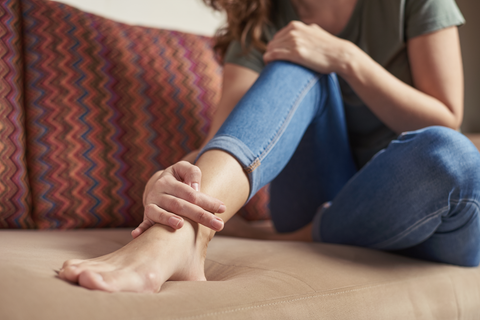While there are many detailed guides to prepare for a marathon, the options for recovery are limited. But, the recovery phase is just as important as the race itself. In fact, many experts consider it the final leg of the event, believing that until you've properly recovered, you haven't truly completed the race. Considering how tough marathons are on your body, here's a complete guide on how to recover faster.
What Happens to Your Body After a Marathon?
Credit: Envato Elements/ YuriArcursPeopleImages
After finishing a marathon, your body will go through a series of changes. At first, you might feel a rush of adrenaline, but soon after, fatigue will begin to set in and you will experience soreness. This is because you've used up your energy stores and have microscopic tears from the intense physical activity. Your immune system will also be impacted, making you more vulnerable to colds and other infections in the days immediately following the race. Also, you may experience dehydration since your body has lost a significant amount of fluids and electrolytes through sweat.
How Long Does It Take to Recover From a Marathon?
Credit: Envato Elements/ benzoix
Recovery can vary greatly from person to person and depends on factors such as your level of fitness, age, and how well you prepared for the race. Generally, it takes about two to three weeks to get back to your normal routine.
When Can You Start Running Again?
Credit: Envato Elements/ Pressmaster
Typically, it's recommended to wait at least one week before you can ease back into your routine. After the initial week, if you're feeling good and don't have any lingering soreness or fatigue, you can start to introduce light jogging or easy runs to back into your marathon mode.
How to Recover from a Marathon
Credit: Envato Elements/ Lazy_Bear
If you want to recover from a marathon faster, consider following the tips below:
1) Consider Getting a Post-Marathon Massage
After finishing a marathon, it's a good idea to think about getting a sports massage to help your body recover. A massage can help with muscle stiffness and soreness by boosting blood flow to your muscles.
It's recommended to wait at least 24-48 hours after the race before getting a massage. It's also a good idea to go for a gentle massage instead of a deep tissue one right after the race. When you book your massage, tell the therapist that you just finished a marathon. This way, they can adjust the massage to fit your recovery process.
2) Use Massage Balls
Massage balls are handy tools that can help ease tight and sore muscles. They work like deep tissue massages but let you control the pressure and focus on specific areas.
To use a massage ball, find a comfortable spot to sit or lie down. Put the ball under the muscle you want to massage, like your calves, hamstrings, glutes, or back. Lean onto the ball gently, using your body weight, and roll it around the area to massage the muscle. If you feel a tight spot, pause and press on it for about 20 to 30 seconds to help release the tension.
It's important to use the massage ball gently, particularly in the first few post-marathon days, as your muscles will be very sensitive. Start with light pressure and gradually increase it as your muscles loosen up. Consider doing this a couple of minutes a day.
3) Try Contrast Baths
Contrast baths involve soaking in warm water, then switching to cold water, and repeating the process. It helps ease muscle soreness, reduce the chance of DOMS (delayed onset muscle soreness), and decrease inflammation.
Here's how to do it: You'll need two tubs or large buckets—one with cold water (around 50-60°F or 10-15°C) and the other with warm water (around 100-110°F or 37-43°C). Start by soaking your legs in the warm water for about 3-5 minutes. Then, switch to the cold water for another 3-5 minutes. Alternate between warm and cold for about 3-5 cycles, always ending with cold water. Do this within the first 48 to 72 hours after your marathon for maximum effectiveness.
4) Try Active Recovery
After crossing the finish line, the idea of active recovery might seem a bit odd—like, you just ran 26.2 miles, and now you're supposed to keep moving? But let us explain. the idea here is to keep the blood flowing to your muscles without pushing them too hard. This helps to reduce stiffness and soreness by moving nutrients and oxygen through your body and speeding up the removal of waste products from your muscles. Plus, getting moving can also help keep your spirits up and reduce that post-marathon slump that some marathon runners experience.
In the days after the marathon, try adding some light activity to your routine. Take a relaxed walk, do some gentle cycling, or go for a relaxed swim. Yoga can also be great for stretching tight muscles and improving flexibility. Start with just 10-15 minutes and see how you feel. If you're feeling good you can gradually increase the time, but always listen to your body. If something hurts, take it as a sign to rest.
5) Get Adequate Sleep
One of the best things you can do for your body is to catch up on some quality sleep. Try to aim for at least 8 hours of sleep per night, but don't stress if you need more. Also, consider creating a calming bedtime routine to help improve the quality of your sleep. Avoid screens an hour before bed, maybe read a book or try some gentle stretches or meditation to help your body and mind unwind. Lastly, keep your sleeping area cool, dark, and quiet to encourage deep sleep.
6) Refuel Your Body
This is perhaps the most important recovery strategy. Your body needs a variety of nutrients to repair muscles, replenish energy, and balance electrolytes.
First, focus on hydration. Water is great, but also consider drinks with electrolytes to replace what you've lost through sweating.
Next, think about food. In the first week after the race, you might not feel super hungry, and that's okay. Begin with something light and easy to digest, like smoothie bowls and green juices. Avoid energy bars and opt for meals that naturally boost your energy. As your appetite starts to return, aim for a balanced meal with carbohydrates, protein, and fats. Carbs will refill your energy stores, protein will repair muscle damage, and fats are essential for overall recovery.
7) Treat Any Blisters
There's a good chance you've earned yourself a blister or two after your post-race celebration. If yes, don't pop them! As tempting as it may be, popping blisters can lead to infections, and that's the last thing you need. Instead, clean the area gently with soap and water to remove any dirt and reduce the risk of infection. After cleaning, apply an antibiotic ointment and cover the blister with a bandage to protect it.
If a blister happens to break on its own, don't panic. Just clean the area carefully, apply an antibiotic ointment, and cover it with a sterile bandage. Keep an eye on it for signs of infection, such as increased redness, swelling, or pus.
For blisters that are particularly large or painful, consider using a blister plaster. These specialized bandages provide extra cushioning, protecting the blister from further friction and promoting healing.
Also, let your feet breathe when you can When you're at home and don't need to walk around much, leave the blisters uncovered to let them dry out faster.
When Should You Visit a Specialist?
Credit: Envato Elements/ Image-Source
After pushing your body to the limit, it's pretty common to feel aches and pains. However, there are times when it's best to see a specialist instead of just riding it out.
For instance, if you're experiencing persistent pain that doesn't improve with rest and recovery efforts, it's a sign to see a sports medicine specialist. This is especially true if the pain is localized and sharp, as it could indicate a more serious injury like a stress fracture or a muscle tear. Also, if you notice swelling that doesn't go down with ice and elevation, or if an area feels warm and looks red, it could be a sign of infection or a more serious problem that requires a specialist's attention.
Summary
Recovering from a marathon requires patience, diligence, and a proactive approach to self-care. By following these practical guidelines, you can optimize your post-race recovery and return back to your normal life. And for an extra boost in your recovery routine, consider using Acupoint massage balls. These handy tools can target sore muscles and provide instant relief, cutting your recovery time in half. Shop with us today.















